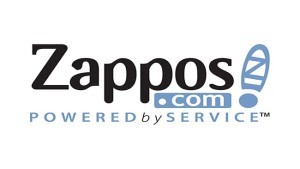Dan Pontefract's Blog, page 34
July 20, 2015
Humans Should Aim To Be The Next Us
In 1982, Time magazine declared the personal computer its “Machine of the Year.” Up until then, humans usually had won a “Person of the Year” distinction.
Time publisher John A. Meyers wrote:
“Several human candidates might have represented 1982, but none symbolized the past year more richly, or will be viewed by history as more significant, than a machine: the computer.”
Pity those worthy humans who might have been in contention. The year 1982 was the point in history when humans became mere mortals, suffering the ignominy of garnering second place to a machine.
It hasn’t got much better. Some 33 years later, we might suggest 1982’s “Machine of the Year” has now morphed into an omnipresence of highly sophisticated technologies, outperforming and outsmarting those fallible humans.
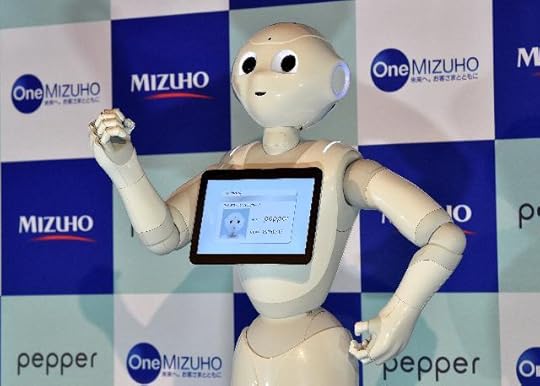 (YOSHIKAZU TSUNO/AFP/Getty Images)
(YOSHIKAZU TSUNO/AFP/Getty Images)Today’s “Machine of the Year” is no longer solely the personal computer either. It’s everything with an IP address. It’s my fridge!
More alarmingly, perhaps Time’s “Person of the Year” distinction – you know, humans – is becoming irrelevant, destined for a future of runner-up badges to the almighty machine. Wearables, big data, robotics, cloning, telepathy, the “Internet of Things” and the pending “singularity“ – perhaps better stated as the rise of Artificial Intelligence – is no longer relegated to the futuristic thoughts of Orson Welles or Elon Musk. Indeed, the future is now.
There are warning signs ahead that leaders ought to pay attention to.
Firstly, are we destined to put technology ahead of humanity? Leaders of people ought to be equipped to handle the continued onslaught of technology innovation but doing so such that they don’t make the mistake Time magazine made in 1982. We mustn’t allow the machine to replace the true purpose of an organization. We mustn’t abdicate the responsibility of leadership so advanced machinery supplants the very basis of civilization. The workplace will not survive if we put machine before man or woman.
Secondly, just as the roads of yesterday will not take us to the places of tomorrow, old technology hasn’t ameliorated bad management. The typewriter coded letter turned into a Microsoft Word document which turned into a shared Google document. The face-to-face meeting turned into the conference call which turned into a webcam meeting. For many leaders, ironically, these “machines” and innovative advancements have not helped them to become better leaders. If anything, it has made them worse. Distraction looms and inconsiderate use of the technology prevails. It’s analogous to the Victorian era cotton mills, when people were treated as slaves to the machines, and considered dispensable.
So while we continue to develop these new forms of functionality, levels of employee disengagement and disenfranchisement remain at anemic levels. For every Enterprise Social Network we launch and implement, millions of workers remain left out. For every technological advancement invented, there are millions of employees who remain dissatisfied and unrecognized for their efforts at work. Are we trying to let the machine make up for poor leadership?
Thirdly, there is irony. A Chief Information Officer mandates a certain collaboration platform to be installed across the organization – because one of their CIO friends did the same a few months back – but doesn’t once contribute or participate. This is an individual who has misunderstood the benefit of collaborative behavior. Open leadership? Not even close. When a CEO begins to blog on the company’s corporate website – but employees discover it’s full of ghost-written entries by members of the firm’s corporate communications team – it fuels the fire of deceitful behaviour.
If as author Andrew Keen suggests, The Internet Is Not the Answer, and author Nicholas Carr claims we are now operating our organizations in a Glass Cage, what are leaders doing to ensure human behaviour continues to flow – as Plato taught us – via the three main sources of “desire, emotion and knowledge?” If the technology that we are implementing into our organizations is eliminating an employee’s desire and her emotion, while confusing the transfer of knowledge, I argue it is the antiquated behavioural models that we currently have in place in the organizations itself that are causing such dire employee disengagement aftereffects. The technology isn’t helping; indeed it’s simply masking the root problem. The presumption continues that an infusion of new technologies will somehow solve the greater issue. Ultimately, the behaviour remains the same.
Socrates once stated, “The secret of change is to focus all of your energy, not on fighting the old, but on building the new,” yet we must also remember that pre-existing behaviour tends to trump enhanced technology functionality. If there is a culture of fear at your place of work, no amount of technology is going to help.
As we continue to develop new technologies and as we seek new growth in our businesses, leaders need not worry about delivering the next new “Machine of the Year” as that will happen anyway. Society has proven over and over again we are pioneers of innovation.
But to truly prosper – to ensure society comes before machine – leaders must develop and inculcate new behaviours that are open, collaborative and inclusive across the organization in step with the technology itself. We must put humanity ahead of and before the technology expansion.
Perhaps we humans should aim to be the next “us,” rather than developing intelligence machines that we plan to build to replace us.
Let “us” put the machine in its place. If we want that to happen – if we want to enhance our own humanity in concert with the technology – leaders best begin the process of introducing and balancing new forms of open and collaborative behaviours with employees and peers, in parallel with the technologies we are thoughtfully, and thoughtlessly, introducing to society.
If we fail to deliver on a proper balance, expect to see plenty more “Machine of the Year” distinctions in the future.
And if this imbalance continues, it’s our humanity that will potentially suffer.
__________
Dan Pontefract is the author of FLAT ARMY: Creating a Connected and Engaged Organization and is Chief Envisioner at TELUS Transformation Office.
Dan's Related Posts:Stack Ranking the RobotsHolacracy Is Not The Answer To Your Employee Disengagement IssuesConation: The Word of 2015If Your Enterprise Social Network Is A Ghost Town It’s Probably Due To Your…Waxing Lyrical On Leadership, Engagement, Purpose & Innovation
July 10, 2015
Sophomore Blues Sabbatical
When you fly into Australia direct from another international destination like Singapore, Los Angeles or London, country law dictates the airline must decontaminate the airplane for any potential insecticides before anyone may disembark the plane. If it’s your first time to Australia you might think you’re on the set of the movie Ghostbusters or worse, caught up in an international flu pandemic.
 Once the landing has completed and the pilot has pulled the plane up to the gate, flight attendants parade up and down the aisles spraying a World Health Organization approved aerosol disinfectant. You have no idea what it is, but there is an implicit trust that Australia — and by association, the flight attendants — know what they’re doing. They’re acting on behalf of the interests of an entire country.
Once the landing has completed and the pilot has pulled the plane up to the gate, flight attendants parade up and down the aisles spraying a World Health Organization approved aerosol disinfectant. You have no idea what it is, but there is an implicit trust that Australia — and by association, the flight attendants — know what they’re doing. They’re acting on behalf of the interests of an entire country.
I find myself needing to apply some form of disinfectant to the fuselage that makes up my current professional projects.
In particular, I’ve recognized over the past several weeks that if I want the Dual Purpose book project to safely and successfully disembark, my own patterns and behaviours must change.
I have a case of the sophomore book blues. To combat it and to ensure I improve the final result, I’ve decided to take a sabbatical from all other forms of social. That includes contributing, participating or mingling in personal/professional social networks whether face-to-face or digital. This includes coffees, beers, and lunches. This includes other forms of writing.
As hard as it might be for someone who draws his energy from other people, a 60km bike ride today put things into perspective.
I need a different strategy.
Thus, I’m applying the disinfectant.
Call it the ‘sophomore blues sabbatical’. (that should be the name of a band)
See you on the other side, whenever that is.
Dan's Related Posts:Why Don’t We Tip Flight Attendants?Air Canada Isn’t Collaborating With Its EmployeesI’m Showing My Work … My Next Book Is PostponedRedefining the Social EmployeeThe 10 Winners of Flat Army Copies Are …
“Oh, you’re one of those. You want to work anywhere, anytime.”
My first few days as a team member at TELUS in November of 2008 were rather interesting.
“Here’s your office, Dan,” said the charming woman, gleefully pointing to a cavernous room that consisted of an oak desk the size of a canoe and a view of the parking lot. “There’s your PC, desk phone…and over here is a table where you can have your meetings.”
She was a lovely woman, doing as she had always done, perhaps a hundred times over.
Of course, I wanted nothing of it, causing a minor stir of incredulity that first day.
“What if we gave back the office, and the PC, and the telephone,” I asked. “Would that be a problem?”
At first, I thought she was about to strike me with the stapler she was holding in her hand. Thankfully, she did nothing of the sort. As a bonus, the stapler looked empty, too, so there would be no staples masquerading as bullets flying past my head.
 Pedestrians pass in front of the TELUS Corp. building in Toronto, Ontario, Canada. Photographer: Aaron Harris/Bloomberg
Pedestrians pass in front of the TELUS Corp. building in Toronto, Ontario, Canada. Photographer: Aaron Harris/Bloomberg“You mean,” she began, “you don’t want an office?” She put the stapler down, and for a moment I truly thought she was about to pick up the soon-to-be orphaned desk phone and start hitting me with it.
“Not really,” I awkwardly responded. “I’d like to be able to move around, work from home, be in different buildings and generally work from anywhere.” She was beginning to go for the phone. “But I do appreciate what you’ve done,” I implored with heartfelt sincerity. “I’ll do whatever it takes to ‘send it back,’ if need be.”
My new friend quickly began to connect the dots. “Oh, you’re one of those,” she said. “You want to work anywhere, anytime.”
“Exactly!” I exclaimed. “I want to work anywhere, anytime.”
Without skipping a beat, she replied, “I wish I could do that. I really wish I could work anywhere, anytime.”
These days at TELUS, more people than ever before are working anywhere, anytime. And that type of operating culture is paying dividends in many facets of our overall customer, business, team member and community strategies.
Take for example our employee engagement scores. Since formally implementing Work Styles – a flexible work program empowering team members at TELUS with the tools, resources and support to work when and where they’re most productive – we have witnessed employee engagement shift from 57% to 85%. We utilize Aon Hewitt for our twice-annual engagement surveying, and the firm has informed us that our employee engagement score is “number one globally amongst organizations of similar size and composition.” Not only are we proud of that distinction, in 2015, once again TELUS was named to Canada’s Top 100 Employers list.
But employee engagement is but one aspect that demonstrates TELUS’ flexible working arrangement and model is, err…working.
Since 65% of TELUS team members work from home 100% of the time (called at-home team members) or work from a combination of locations including an office and the home (called mobile team members) we have witnessed a significant contribution to the environment and our communities.
For example, in 2014:
We avoided 5,645 tonnes of CO2e simply by driving less to the office; and
We saved 1.3 million hours of commuting time that equated to 22.7 million less kilometers on the road.
Furthermore, because we believe in spirited teamwork (whether we’re at an office, at home, at a customer site, or elsewhere) our use of collaborative technologies and reduced travel – and the open leadership principles that we have employed since 2010 – predicts TELUS will save $63.5 million over a 13-year period, monies we can invest into our team members and our Customers First strategy.
Would you be surprised to know TELUS has reduced its overall real estate footprint by one million square feet since 2010 as well? As a result, we’ve lowered our real estate costs by $50 million annually, which also helps our 2020 goal of reducing our overall carbon footprint by 25%.
Simply put, the efforts applied to the TELUS Work Styles program has not only resulted in a return on investment, it has demonstrated a return on engagement and a return on environment. Perhaps it’s a new triple bottom line.
I never did take that office, back in November of 2008. Six-and-a-half years later, I’m still working, anywhere, anytime.
And like many other team members at TELUS, I feel a sense of purpose in my work and a deep commitment to our Customers First strategy.
Now, where was that stapler?
If you’re interested, feel free to download the TELUS Work Styles infographic.
Originally published to Forbes.
__________
Dan Pontefract is the author of FLAT ARMY: Creating a Connected and Engaged Organization and is Chief Envisioner at TELUS Transformation Office. His next book, DUAL PURPOSE: Redefining the Meaning of Work, will publish May 10, 2016.
Dan's Related Posts:Try Implementing Flexible Work Options to Increase Employee EngagementFive Essential Tips to Effectively Work from HomeAfter Five Years In My Role We’re Hiring My Replacement. Are You Interested?Flexible Working WorksMy Next Role Is …
June 25, 2015
I’m Showing My Work … My Next Book Is Postponed
In her book, Show Your Work, Jane Bozarth encourages us to work in the open. On the topic, she recently wrote, “Working out loud takes us off autopilot and forces us to confront assumptions, bad habits, and prejudices. Helping others better articulate decisions helps them learn—and if we’re paying attention, we might learn something, too.”
John Stepper is another fabulous example of mastering the “work out loud” nascent meme. He even recently published a new book titled, Working Out Loud. He once wrote that, “You need to make [working out loud] purposeful in order to be effective.”
I’ve looked up to Jane and John for many years now (mostly virtually) as they have perfected the art not only of working out loud, but of building networks to increase their own knowledge and success. It’s been beautiful to watch from afar. For they are beautiful at working out loud.
I like to think I’m open. I like to think I’m collaborative. I like to think I’m (mostly) working out loud. But like most of us, I have plenty of room to grow.
Consider this entry about being open with my work. My other work.
My writing.
When my first book, FLAT ARMY, published in May of 2013 I immediately began sketching, researching, and writing the next book. While FLAT ARMY was a book written to help organizations and leaders launch improvements in their culture and employee engagement practices through connected leadership, pervasive learning and collaborative technologies … I not only had the bug to continue writing, I wanted to delve deeply into the concept of purpose.
At first, I titled the book, “It’s Work Not Jail” and it was about 15,000 words in when I realized it was the wrong book. At the time, the target audience for the book was employees — not a bad thing — but I had an epiphany on a long bike ride. While I’d love to help the millions of employees out there directly with a new book on purpose (at least the thought of potentially helping them), I felt the concept of purpose was so delicately intertwined with employee engagement, that the target audience needed to shift.
Thus, the first book on purpose was mostly scrapped, and I started fresh. (or, perhaps I started over)
I recognized through more research, interviews, and personal reflections that purpose is in fact a two-fold process. First, the organization needs to define what its purpose should be. Second, employees need the resolute assistance of leaders to determine how they might evolve from a job or career mindset into what I believe is a ‘purpose mindset’. (Of course, the purpose mindset is aided and abetted by a more wholesome and stakeholder-driven definition of the organization’s new purpose.) This is why my next book is titled DUAL PURPOSE.
Since the Spring of 2013, I’ve written and rewritten this next book several times.
I’ve ventured into the memory vault of my own prior roles and organizations. I’ve researched till my fingers bled. I’ve interviewed many people — be it on the organizational or employee side of purpose.
In April of 2015, I finished the first complete draft. I did a little dance in the kitchen. Even the goats laughed at me.
Over the next two months, five different people read the book. Great comments. Insightful recommendations. Cheeky shots at my propensity for long sentences or made-up-words aside, the book was coming along. And then the paring began. It was 100,000 words and was being whittled down to something more manageable. An appendix was even created, so the flow of the book made more sense versus some of the stories that could be read almost anecdotally.
Prior to completion (in 2014 and 2015), five other people had read bits and pieces of the book. Again, fabulous feedback was received and incorporated into the book.
The cover was designed. I loved it. So fab!
I was getting ready to launch. November 10, 2015 was the chosen date. I could taste the anticipation of publishing another book, in hopes of helping organizations and leaders with this concept called ‘purpose’.
It was time for endorsements. I didn’t seek out endorsements for FLAT ARMY, instead choosing to define the words flat, army and flat army on the back cover. But for DUAL PURPOSE, I thought it was time to try something different.
Over the years I feel as though I have morphed into the world’s most fortunate aspiring writer. I have met many of the heavyweights and rock stars from the leadership and management space. Whether they have been CEO’s, consultants, ex-consultants, ex-CEO’s, academics, industry analysts, authors, broadcasters, and so on … I’m so lucky in some cases to even have developed a relationship.
I decided to call on one of them. The galley was issued. (galley is ‘book-speak’ for a not complete book) Some time lapsed. If the leadership and management space had some sort of articulated equivalent, in my mind, I was essentially ringing on the doorbell of Abbey Road, asking one of The Beatles for their approval.
Today, I got a response.
It was not positive.
Not at all.
At first I felt as though Lennon might have quipped, “You’re only playing three chords, and your G isn’t that good either.”
Gutted. For the entire morning I was not a member of Earth. My mind may as well have been on Mars, searching for water.
I got on an airplane. Then I got on another one. Before taking off on airplane #2, a flight attendant approached me in my economy class seat and asked:
“Would you like to take 3A in business class?”
“Would I?” I shrieked. “You have no idea.”
So, I plopped myself in 3A and pulled out my iPad. I’m on a cleanse now, and although tempted by wine, I had the wherewithal to pass.
I re-read Lennon’s long and so very thoughtful email roughly fifty times. Each time I read it, my degree of hopelessness lessened and my sense of forlornness dissipated. The comments were structured and blunt but written in the spirit of making the book better. Lennon wasn’t trying to attack me; Lennon was attempting to help me make the book a much better book.
An offer of assistance was included. It was as though Lennon had asked an Indie band to jam with him for a period of time.
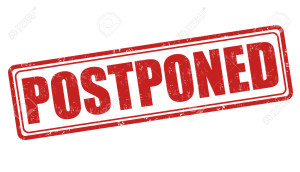 It doesn’t even pain me to write this, but DUAL PURPOSE will not publish on November 10, 2015. I don’t know when it will publish, but if Lennon thinks there’s a few more chords to utilize and songs to write, that’s good enough for me.
It doesn’t even pain me to write this, but DUAL PURPOSE will not publish on November 10, 2015. I don’t know when it will publish, but if Lennon thinks there’s a few more chords to utilize and songs to write, that’s good enough for me.
I’m working out loud. Thanks Jane Bozarth and John Stepper.
And thank you so much, John Lennon.
Dan's Related Posts:My Definition of Work and an Update on Book TwoIn 2015, Will I …Three Types of Workplace MindsetsWhat Should The Title Of My Next Book Be?Corporate Culture in a Venn Diagram
June 24, 2015
Taylor Swift and Apple Demonstrate How You Work Things Out In The Open
I’ve had music pop star Taylor Swift on my mind for the better part of a year. It could have something to do with my young girls repeatedly playing her latest album, 1989, (bought on iTunes, naturally) since it released.
As a consequence, even I know all the words to the song “Out Of The Woods” now.
 But Taylor Swift is not only a musician, she’s a shrewd businesswoman. She’s not only a shrewd businesswoman, she’s a staunch advocate of people paying for art.
But Taylor Swift is not only a musician, she’s a shrewd businesswoman. She’s not only a shrewd businesswoman, she’s a staunch advocate of people paying for art.
Last year, she decided to pull her music from online music streaming service Spotify. Speaking with Time, Swift said, “I think there should be an inherent value placed on art.” That decision was made in early November, but clues were dropped earlier in the year of the inherent value she places on art, like music.
For example, in an Op-Ed piece penned to the Wall Street Journal, Swift wrote:
Music is art, and art is important and rare. Important, rare things are valuable. Valuable things should be paid for. It’s my opinion that music should not be free, and my prediction is that individual artists and their labels will someday decide what an album’s price point is. I hope they don’t underestimate themselves or undervalue their art.
Apple recently decided to get into the streaming music business. Playing catch-up to competitors like Spotify, the company purchased Beats in 2014, which came with the streaming service, Beats Music. In June of 2015, Apple retooled parts of Beats Music to announce Apple Music, the company’s attempt to enter the fray of streaming music services.
With Swift’s recent decision regarding her music on Spotify – not to mention the Op-Ed piece at the Wall Street Journal – one must have assumed (if you work for Apple) that she would respond at some point.
When Apple announced Apple Music on June 8, the company indicated its customers would be able to sign up for a free three-month trial membership. It’s the classic “try before you buy” adage.
It sounded good to everyone.
Except Taylor Swift.
You know, the artist whose latest album, 1989, had sold over 8.6 million copies worldwide by February of 2015, according to the .
Artists just don’t sell albums like that anymore, it seems.
While the free three-month trial membership to Apple Music might have looked great to consumers (and to Apple as a way to entice people to purchase its new service) it was the fine print that irked Swift.
The artists weren’t going to be paid during this three-month trial period. Their music would be available, but whatever arrangements Apple set up with the music recording industry players resulted in no payment to the musicians (err, the artists) during the trial period.
On June 21, Swift penned another column (this time on Tumblr) titled, “To Apple, Love Taylor.” In it she wrote:
Three months is a long time to go unpaid, and it is unfair to ask anyone to work for nothing. We don’t ask you for free iPhones. Please don’t ask us to provide you with our music for no compensation.
The column was gobbled up by mainstream and social media outlets. It was everywhere.
Seventeen hours later, Apple responded with a couple of tweets, via Eddy Cue, the company’s senior vice president of Internet Software and Services, reporting to CEO Tim Cook:
Apple will always make sure that artist are paid #iTunes #AppleMusic
We hear you @taylorswift13 and indie artists. Love, Apple
That is, the company reversed its decision and any musician (err, the artists) will now be paid during the Apple Music three-month trial period.
How is this story a demonstration of open leadership?
Let’s start with Taylor Swift.
In the case of Spotify, Swift and her management team pulled her music behind closed doors, and seemed to leave it at that. To this day, Swift’s music is not available on Spotify, and neither side has truly openly debated or discussed the situation.
In the case of Apple Music, before the music streaming service ever commences operations, Swift openly wrote an opinion piece (via her Tumblr post) that outlined her concerns and wishes. Sure, she stated her music would not be available unless things changed, but the openness and thoughtfulness of the piece gave Apple time to react. She wasn’t writing or sticking up for herself. Indeed, she was writing on behalf of the artists who can’t afford to go three months without being paid. That is a remarkable demonstration of open leadership.
The ball then swung into Apple’s court. What to do? Ignore the backlash and the army of Swift supporters?
It took 17 hours!
Apple could have balked, hidden behind company (and legal) walls or simply ignored the problem. Many organizations do this.
Instead, it took all of seventeen hours to reverse the decision. And how did the reversal get communicated?
Openly, via Twitter, of course.
Peter Kafka of Re/Code caught up with Eddy Cue after the Twitter announcement reversing the decision, and Cue stated to him:
I did reach out to Taylor today, and talked to her, and let her know that we heard her concerns, and wanted her to know that we were making changes. She was thrilled to hear from us and that we were making the change, and we were grateful for that.
For me, with Cue calling up Swift, it demonstrated yet another example of open leadership in this short but enlightening story.
And in the end, Swift publicly responded with another tweet:
I am elated and relieved. Thank you for your words of support today. They listened to us.
What’s the lesson?
Be open. It can do wonders for your business and your brand.
Maybe both Apple and Swift are now “Out Of The Woods.”
Originally posted to Forbes.
__________
Dan Pontefract is the author of FLAT ARMY: Creating a Connected and Engaged Organization and is Chief Envisioner at TELUS Transformation Office. His next book, DUAL PURPOSE: Redefining the Meaning of Work, will publish soon.
Dan's Related Posts:Apple CEO Tim Cook and his Moment of Open CultureLessons in Leadership From Jim Balsillie and Mike LazaridisI Wrote a 90,000 Word Book Entirely in EvernoteThat Decision Is Above My Pay-GradeIf Your Enterprise Social Network Is A Ghost Town It’s Probably Due To Your…
June 13, 2015
I Missed My 25th High School Reunion That Never Was
This week, twenty-five years ago, I graduated from high school.
Technically speaking, I’m now old.
I have no hair, I’m a size 34 waist (ok, probably 35 on Saturday nights) when I should be a 32, and the 12-, 10-, and 8-year olds parading around our home, masquerading as ‘children’ and causing irreparable havoc, occupy 134% of my free time.
As I turn 44 years old myself next weekend (hint hint, family), I consider myself at “Peak Dan”. I reckon I’ll live to the age of 88, so from here on in, there’s no going back. I’m old, and I’m getting older by the minute. As far as I understand 1st century engineering, the sands of the hour glass don’t possess an off button.
Having been born in 1971, I’m smack in the middle of the GenX cohort age bracket. Translation? I’m halfway between contempt for all that the Baby Boomer’s have achieved (and partially screwed up) and all that is made of the Millennials via their mainstream-media depicted “saviour of the Western world” taxonomy.
I’ve become the middle child. I’m not used to this at all.
Even though I’ve been tattooed by author Douglas Coupland as a member of the GenX cohort, born between 1965 and 1981, I’ve grown somewhat weary of those in my age bracket, accurately depicted by their pessimistic, itching to outdo yet often skeptical behavior in films such as Reality Bites, Singles or Fight Club. The brooding, nihilistic and jaded attitude of many GenX’ers (but certainly not all) has become a bit too much for my liking. I think I’m ready for a brand change, but not like the disaster that was New Coke.
Because I am one of them — those cantankerous GenXer’s — it’s going to take a lot more mindfulness and meditating to undo my own DNA. (In fact, I may have to steal my son’s singing bowl.)
Part of my interest these days lies squarely with a Millennial’s disposition. This is the cohort of Earth’s citizens born between 1981 and 2000. My brother, Adam, is a Millennial, born 14 years after me to the same parents. Through his teens and early 20s, I didn’t understand why his attitude was so “half full” when he encountered life’s unpredictable yet certain potholes and storm clouds.
I’ve grown to appreciate my brother’s rather easy going attitude, and have become rather envious as he inches into his 30s and I into my mid-40s. Adam turns 30 on June 21! In hindsight, I feel as though I’ve missed out on a decade of happier times when I was in my 20s. My natural temperament was to judge and find fault and compete, arguably any GenXer’s chromosome deficiency. Adam has always been one that naturally produces smiles and understanding in both the darkest and lightest of times. He has often battled the bumps of life in the company of others, asking for assistance whenever needed. I think I’ve come a long way, but Uncle Adam and his Millennial DNA is far wiser than I was in my 20s.
Of course Denise and I are raising “goats”, too. The homemade herding is providing me with another anthropological inquiry. The “kids” are classified as Generation Z by some, born between 2001 and 2015. So far, whilst they are certainly tech savvy, they’re also exhibiting far more collaborative and sharing-like behaviours than I ever remember exhibiting during the 1980’s. Their competitive streak seems to be higher than their “blue ribbon” Millennial counterparts, but on the surface it might be that they’re a generational mash-up of Baby Boomers and Millennials. Mind you, I think it’s only the good bits.
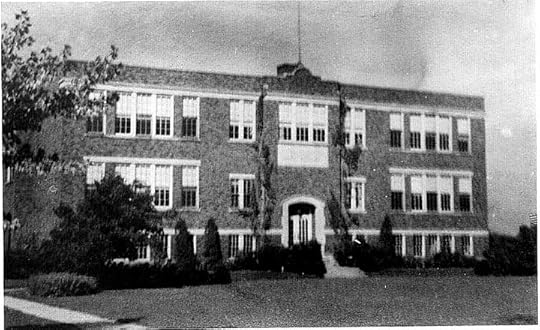 Saltfleet High School, before it was demolished.
Saltfleet High School, before it was demolished.It brings me to a moment of recollection and reflection.
As I mentioned, twenty-five years ago, I graduated from high school.
Where the Hell is the reunion?
It’s a big deal, isn’t it? Maybe they didn’t invite me.
Between 1985 and 1990 I attended Saltfleet High School in Stoney Creek, Ontario. Back then, high school in Canada’s most populated province occurred between grades 9 and 13. The other provinces thought we were just a wee bit slow, what with their own high school tenure concluding at grade 12 and ours at grade 13. I think it just allowed some of us the opportunity to have a beer at lunch, once we turned nineteen and became of ‘legal’ age to drink. There were a few liquid lunches, I was told, on occasion in 1990.
Never me though. Never!
 Like any high school experience for any teenager anywhere, there were millions of fond and not-so-fond experiences to remember. There was the epic outdoor “air band” concert, first kisses at “The Dairy“, competitive euchre tournaments on spares, and practical jokes on Mr. Cann. (His first name was John, so ‘them was easy pickings.’) The cafeteria “beaver ladies” somehow mastered the art of serving extra fatty french fries and 550 calorie chocolate chip cookies, while the regal, English-bred vice-principal had to put up with my morning “radio show“. That’s right, yours truly was ‘in charge’ of the morning announcements. It came with my post as student council president. (How they let ‘me’ be president is still a mystery.)
Like any high school experience for any teenager anywhere, there were millions of fond and not-so-fond experiences to remember. There was the epic outdoor “air band” concert, first kisses at “The Dairy“, competitive euchre tournaments on spares, and practical jokes on Mr. Cann. (His first name was John, so ‘them was easy pickings.’) The cafeteria “beaver ladies” somehow mastered the art of serving extra fatty french fries and 550 calorie chocolate chip cookies, while the regal, English-bred vice-principal had to put up with my morning “radio show“. That’s right, yours truly was ‘in charge’ of the morning announcements. It came with my post as student council president. (How they let ‘me’ be president is still a mystery.)
I attended our goats’ school closing ceremonies this week. Thankfully they have been ‘promoted’ to grades seven, five and three respectively so I can put away the caning manual.
But the pomp and circumstance really got me thinking.
Why didn’t anyone organize a 25th anniversary reunion for our high school graduation year? Was it because we’re GenX’ers, brooding over life’s miseries? Was it because they bulldozed the school a few years after we graduated — apparently there is no such thing as ‘heritage status’ for 75+ year-old buildings in Stoney Creek — building a new one kilometers away? Was it because “Reality Bites“?
Were the five years of high school a forgettable experientia?
Nonetheless, twenty-five years later, I feel nostalgic and somewhat culpable. After all, I am Canadian.
There were many moments of love, happiness and learning during high school. In retrospect, that half decade was a wonderful experience. Firsts rained down like water does during a North Vancouver January. The nostalgia of high school ebbs and flows, perhaps more so now that I approach the back half of “Peak Dan“. I’m now officially closer to death than birth. Introspection indeed breeds lucent visions of yesteryear.
In 1990, I left my hometown of Stoney Creek for Montreal. A higher education degree beckoned, and I was on the hunt to marry Mitsou. By 1995 I was married (not to Mitsou) and living in the City of Glass, Vancouver. By 2011, with three goats grazing heavily and a return to ‘small town’ circling our marital headspace, the quaint hamlet of Victoria called.
When I departed for Montreal, however, I never returned to Stoney Creek. My parents moved to Ancaster — a town some 30 kilometres away — and then divorced. I never lived with them again, remaining in Montreal for summer breaks and then immediately moving West after marrying. In essence, I divorced Stoney Creek as well during the process.What a GenX kinda thing to do.
In that divorce came, perhaps, an unreasonable separation from my high school, and my hometown, and my memories.
Hence, in a moment of reflection, I feel partially responsible (culpable, indeed) for not organizing a 25th high school reunion. Sure, there’s an “Old Saltfleet High School” Facebook group, but no one from “Class of 1990″ is on there, let alone chatting up a reunion party. I don’t know Darryl Buckle, but he’s like a 24-hour DJ on that site. I certainly haven’t posted anything. Speaking of Facebook, I’m only connected with a half-dozen or so people from my actual graduation year. With over 200 graduates, that seems odd to me as well.
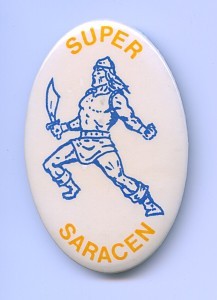 Am I being too much of a GenXer? Probably.
Am I being too much of a GenXer? Probably.
Can I learn from Gen Z and the Millennials? I would think so. They probably would have held a 25th reunion party. (Editors Note: ask one of your children to organize a 30th)
I’m sorry there isn’t going to be a 25th high school annviersary for Saltfleet graduates of 1990 (or 1989 or 1991, etc.) If you’re a Saracen, from whatever era, it would be great to hear from you.
Maybe one day we’ll have some sort of reunion party and reminisce about bush parties, Taco Bell lunch competitions, Mr. Baxter’s tongue (and wandering eye), “the strap”, miner niner day, typewriting, yearbook club and those legendary MC Mike DJ’d dances.
Maybe it’s a step closer to becoming less like a GenXer.
Dan's Related Posts:The Hierarchy of EducationPlease Don’t Let There Be Anonymity After DeathYa, I Cry at Work. Do You?Leadership Lessons From Late Night King David LettermanWhy I’d Work With Google’s Laszlo Bock (one day)
May 31, 2015
Calling Frederic Laloux Of Reinventing Organizations
Dear Frederic,
I read your book, Reinventing Organizations.
First off, congratulations on becoming a published author.
I’m wondering if you’ve read my first one, FLAT ARMY?
Regardless, there are parts of your book I rather enjoyed. But when I came up against ‘Teal‘, I began having my doubts. Particularly as it relates to … well, a lot that has to do with Teal. Its implementation and feasibility in medium and large-sized organizations is of concern to me, so I’d love to understand how it can actually be achieved. (I consider Zappos rather small, at ~1500 employees – and I don’t think ‘Operation Teal’ is fully implemented yet)
I won’t belabor this letter to you, but I’d like to propose a public debate.
Let’s openly (and publicly) debate #ReinventingOrganizations and #FlatArmy. I’ll take the Flat Army angle, and you can defend ‘Teal‘.
I’ll be in Vienna, 5-7 November, 2015, so perhaps we can do it live and in person. (we’ll arrange for someone to record it so others might enjoy in the festivities)
If not, let’s figure out a date and place where this can happen. I understand you don’t travel much, but given I’m based in British Columbia, Canada … I thought we might make it happen whilst I’m in Europe. (Unfortunately, I won’t be back again in Europe until 2016)
I look forward to your response.
Respectfully,
Dan Pontefract
Author of FLAT ARMY: Creating a Connected and Engaged Organization and the forthcoming book, DUAL PURPOSE: Redefining the Meaning of Work.
Dan's Related Posts:Did Zappos Just Ruin Their Culture Or Is It A Brilliant Org Redesign?My Next Book Has A Title And A Publish DateMy Next Book Project Has A Spanking New Book CoverFlat Army Book Launch Party … A Sea of HumanityIn 2015, Will I …
May 29, 2015
If Your Enterprise Social Network Is A Ghost Town It’s Probably Due To Your Corporate Culture
I was speaking at a conference recently, and a question was posed to me from someone in the audience near the tail end of the session.
We deployed our enterprise social network last year, but it’s a ghost town. No one is using it.
I knew what was about to come next, but I politely waited for the question to be asked anyhow.
Why won’t anyone post to it? I mean we spent gobs of money, and invested oodles of time … why aren’t our employees willing to post, or share, or contribute anything?
The convention center room I was stationed at looked like any other convention center room I’ve spoken at over the past decade. They’re windowless and the carpets look as though designers around the world have colluded with one another to see who can come up with the most bizarre patterns possible. I withdrew my gaze that was stuck on the purple, yellow and reddish-turquoise diamond patterned carpet to the audience, and return volleyed a few queries of my own.
Fantastic question. One I know thousands of other companies and organizations are struggling with at this very moment. Tell me, would you describe your culture as one that is open or closed? Do you and your employees operate in a culture of fear or is it a relatively harmonious and engaged environment? Is innovation and ideation a shared experience or left to a few?
You could tell by the body language of the audience member where those answers were going to lead.
We’re a financial services company. Nobody shares anything, and everyone is afraid to speak their mind.
 It was a refreshing and honest answer. The fact of the matter is this story is far too repetitive. It’s happening across many organizations. In part, it’s why enterprise social networks haven’t fully become a crucial component to an organization’s operating practice. Quite frankly, that saddens me because although technology isn’t the answer, enterprise social networks can do so much good for an organization’s culture and engagement.
It was a refreshing and honest answer. The fact of the matter is this story is far too repetitive. It’s happening across many organizations. In part, it’s why enterprise social networks haven’t fully become a crucial component to an organization’s operating practice. Quite frankly, that saddens me because although technology isn’t the answer, enterprise social networks can do so much good for an organization’s culture and engagement.
Consultant Jane McConnell of NetStrategyJMC, has been researching enterprise social networks (ESN) for the past decade. Her latest report — based on surveys from employees in 26 countries representing 280 organizations — also suggests both leadership and culture are affecting the adoption of ESN. Of the nine dimensions to her Digital Workplace Framework research, culture and leadership (two of the nine) have not materially increased.
In the leadership dimension, for example, in the “majority” of organizations more than 80 percent of its leaders only provided vocal support and/or resources versus sustained commitment, conviction AND participation.
In the culture dimension, 75 percent of survey takers in the majority category didn’t feel as though they had the freedom to experiment or take initiative.
Charlene Li has also spent the better part of the last decade researching and writing about aspects of ESN and open leadership in general. Founder and CEO of Altimeter Group and the author of five books, in a recent column on Harvard Business Review, Charlene surfaced data that suggests less than half of the ESN deployed have ‘many’ employees using them regularly. Like me, Charlene is a crusader for a more open and collaborative culture. In her piece, she makes a point that I wholeheartedly endorse:
Our research shows that leadership participation is crucial for collaboration. Leaders know they should engage with employees, especially via digital and social channels. But they don’t, and they offer a string of common excuses such as “I don’t have enough time” or “Nobody cares what I had for lunch.” More than anything else, they fear that engaging will close the power distance between them and their employees, thereby lessening their ability to command and control.
Why use the enterprise social network if it’s going to eradicate my ability to lead … or so the theory goes of many a leader.
But that’s not what grows an organization, nor is it a way in which we should be operating our organizations in the first place.
McConnell writes in her research paper, “Digital workplace maturity is significantly higher in organizations with a culture of trust: there is a strong sense of purpose, decision-making is distributed and people are free to experiment and take initiatives.”
Indeed, part of McConnell’s research corroborates Li’s investigative analysis. McConnell writes, “The digital workplace tipping point comes when well over half of senior management understand the value of the digital workplace, participate and demonstrate sustained commitment.” As is far too common in many organizations, however, senior leaders might provide vocal support but demonstrating active participation and open behaviours (like writing a blog post or posting a video of themselves) just doesn’t regularly happen. We might call it, “lipstick on a pig.”
Sadly, because senior leaders have not yet instituted the correct open and collaborative behaviours inside the organization, they too do not understand the potential good an enterprise social network can create when it comes to improved business processes, ideation, innovation or customer service.
Over at TELUS — a Canadian telecommunications company, and my place of work — a member of our C-Suite regularly publishes short, self-made videos from a webcam on his laptop to highlight successes in the month, recognize individual employees, or simply to share his thoughts. There is a Senior Vice-President who publishes a bi-weekly video friendly ‘rant’, to solicit feedback on his thoughts or ideas from his team. Another Vice-President uses an internal blog to solicit feedback on an important business unit initiative related to customer service.
These are examples of senior leaders using the TELUS enterprise social networks, but the company didn’t simply dump a bunch of technologies on its 43,000 employees and hope everyone would start collaborating.
Over a number of years, a series of organizational-wide behaviour and culture change programs (and models) were introduced including leadership, engagement, recognition, community, learning, career, performance and collaboration. These were used in unison as a way in which to address our number one priority … putting Customers First.
Both Jane and Charlene – and their wonderful research – prove an organization needs senior level support for enterprise social networks to be successful.
But the real secret is hidden in an organization’s operating culture.
If the organization remains closed – if it’s a culture of fear – it doesn’t matter what fancy new features are found in the latest update from your ESN cloud provider.
What matters is if the enterprise social network might aid and abet your overarching culture change, one that is progressively more collaborative and cooperative.
I once asked Tony Bingham — CEO of the Association for Talent Development (ATD) — if he had come across any examples or stories where culture and technology seemed to blend nicely. He recalled a story about Booz Allen Hamilton, an American consulting firm with over 26,000 employees and $5.5 billion in revenues:
Walt McFarland, when at Booz Allen Hamilton, once told me that technology doesn’t make a difference if the culture doesn’t support collaboration. We had this discussion back when the idea of “social learning,” some call it “collaborative learning,” was really beginning to gain traction in the workplace learning profession. In an effort to better serve their clients, Booz Allen was using social technology tools to give their consultants the ability to reach across the organization and tap the knowledge of subject matter experts to solve complex problems. It’s important to note that at Booz Allen collaboration is a corporate value. Working together is built into the company’s DNA. In Walt’s terms the technology, or tools, ‘actualize the culture.’
I’ll keep answering those questions in the convention center rooms. I’m very happy to.
But one day, I hope the questions have more to do with ways in which to augment engaging and open cultures, versus asking why no one is using their enterprise social network.
Originally posted to Forbes.
__________
Dan Pontefract is the author of FLAT ARMY: Creating a Connected and Engaged Organization and is Chief Envisioner at TELUS Transformation Office. His next book, DUAL PURPOSE: Redefining the Meaning of Work, will publish November 10, 2015.
Dan's Related Posts:The Social C-SuiteRethinking the Work of LeadershipThere Is Nothing Wrong With The Term ‘Company Culture’Waxing Lyrical On Leadership, Engagement, Purpose & InnovationQ&A on the Future of Social, Mobile and eLearning
May 19, 2015
Leadership Lessons From Late Night King David Letterman
Dropping various objects off of buildings as high as the sky is tall just might be the very definition of stupid.
But it’s so much fun, too.
Ever witnessed a melon explode into a million pieces, dropped onto the concrete sidewalk from a balcony several stories above ground? The sound is spectacular. Unique even. Like Johnny Cash’s singing. Or Prince Charles’ ears. But the mushroom cloud of red and green watermelon bits — interspersed by speckled black seeds — that creates a radial symmetry of organic beauty is something only Van Gogh or Picasso could dream up. It’s perhaps the first real example of sidewalk art.
 David Letterman taught me that.
David Letterman taught me that.
I know, most of you might think it’s an immature, disrespectful and utterly foolish act to drop items off of a roof or balcony, solely for entertainment purposes.
And you’re probably right. In hindsight, it is rather dumb.
And that’s how many of you will remember David Letterman. He was Late Night’s buffoon.
He was “that guy” who used to drop buckets of paint, oversized rocks or televisions off various New York building roofs to see what might happen. He adorned a velcro suit, hurled himself onto a wall to see if he might stick. He terrorized patrons at fast food restaurant drive-thrus just to make fun of their orders. You thought he was obnoxious. “What an idiot,” you may have muttered when hearing of his antics. You vouched never to watch him again.
He was “that guy” who might otherwise have been coined a curmudgeon. Cantankerous, perhaps. You had heard of the way he interacted and interviewed some of his guests. “Why is he so mad,” you asked a friend. Dave had an edge, for certain. In fact, it was his sharp, intense and at times pointed questioning and conversations that also sent you fleeing for the remote control. Just ask Paris Hilton. “I like the other guy,” you exclaimed to your spouse. “You know, the friendlier one with the big chin.”
He was “that guy” who rather famously — or should it be infamously — started off the 1995 Oscars telecast with the Oprah-Uma joke. I found it hilarious, but they didn’t.
But “that guy” — in his final week as a late night television host — deserves more than your scorn and scrapheap castoff. I’m here to say “Thank You, David Letterman.” I’m here to illustrate that there are leadership lessons to learn from television’s last remaining true broadcaster.
More importantly perhaps, I want you (David Letterman) to know how much I’ve personally learned from you over the many years of watching your late night zaniness.
1. Self-Deprecation
Over the course of 6,028 shows and interviews with some 19,932 guests, you never once made it about “David Letterman.” In fact, the most enduring and endearing characteristic was an unending swarm of self-deprecation. Whether for the show itself, or your own self-described foibles and idiosyncrasies, the predominant portion of guests were put at ease by your goof-ball, aw shucks, I’m an idiot demeanor. This sort of behaviour puts people at ease. I’ve learned to use a self-deprecating style in many of my interactions, most notably as a leader of people.
2. Honesty
There’s a certain element to being a late night television talk show host where honesty is expected. It’s not as though you could have lied about attending the Department of Radio and Television at Ball State University. But when you opened up to a live audience (and millions of viewers on television) about extortion attempts and acts of infidelity, well…that’s about as honest as things can get. In the same vein, you never faked your way through an interview or comedy bit. If the guest wasn’t the sharpest knife in the drawer — hello Justin Bieber — you wouldn’t mince words, nor play down to their lack of intelligence. You were honest, you remained you, and that’s how I learned to remain comfortable in my own skin.
3. Public Love
Although I’m 25 years younger than you, we had our first child at the same time. You’re a late night television talk show host. I’m not. But that didn’t stop you from demonstrating how proud you were — how much love you had developed — when your son, Harry, was born. Subsequently, Harry’s name, pictures and even appearances on the show surfaced over the years. It was PDAs (public displays of affection) non-stop. The best? Publicly quizzing your guests on parenthood tips, so you could become a better parent. (At least that’s how you masked the questions.) The public affection you showed for your precious mother was also infectious. As a result, I’ve learned not to be afraid to say in public, “I love my kids and wife and family.”
4. Involving Others
I feel as though you might have been a part of the “math club” or some other high school team that often (and inappropriately) gets made fun of during the teenage years. Your penchant for involving others — particularly the regular people of society — was first-class. Stagehands like Biff, Pat, Kenny, Tony and Harold always had a role to play on your shows. In the neighbouring community, you’d involve “normal” citizens like Rupert, Mujibur or Sirajul as part of the show. I learned that community is important, and much like in sports it’s the crest on the front not the name on the back that we all play for.
5. Sincerity
You ran a comedy show. That didn’t stop you from being sincere. You presented flowers for Julie Roberts and other guests. You showed deep concern for peace when discussing political and worldly issues with former or current presidents and elected officials. After 9/11 — arguably your sincerest shows ever — you were the capstone of emotional unity. When you returned from quintuple bypass heart surgery, you invited the doctors and nurses that both saved your life, and took care of your recovery. You taught me to never forget those that assist you in life.
I’m 43 years old, and am blessed to have “married up,” now co-parenting a 12, 10 and 8 year old. I met you — David Letterman — well before I ever met my infinitely better half. I’ve known you for more than half of my life, and through this one-sided relationship, I’ve learned to laugh, love, loathe, lead and live.
We’ll never meet. But I wanted you to know that although I was only one of the millions of people who learned from your zaniness and your love of life, it has meant a great deal to many of us.
Thank you, David Letterman.
Your only leadership mistake? You really should have dropped Howard Stern off of those buildings instead of the melons. In fact, you picked the wrong melon.
NOTE: Cross-posted to Forbes and The Huffington Post.
__________
Dan Pontefract is the author of FLAT ARMY: Creating a Connected and Engaged Organization and is Chief Envisioner at TELUS Transformation Office. His next book, DUAL PURPOSE: Redefining the Meaning of Work, will publish November 10, 2015.
Dan's Related Posts:What I Learned From My Daughter About Decision MakingGoodbye Team of Five YearsDear Mister Dylan Benson, you are the Definition of ClassLessons Learned From a First Time Author5 Ways to Become Less Collaborative at Work
May 15, 2015
Did Zappos Just Ruin Their Culture Or Is It A Brilliant Org Redesign?
When Tony Hsieh won the prestigious ACM Programming Contest in 1993, you just knew he was going to do something great with his life. Check out the problem set he and his two teammates had to solve, and you get an acute understanding of just how smart he is.
Three years later, he founded LinkExchange — an online advertising network incorporating the use of banner ads — and promptly sold it to Microsoft in 1998 for $265 million. Not too shabby.
After selling LinkExchange, Tony founded an incubator and investment firm with his friend Alfred Lin (called Venture Frogs), where one of the first investment bets made was on a little online shoe selling company you might have heard of.
A couple of months later, the uber smart 27-year old Hsieh joined the company as its CEO and, well, the rest is history.
Today, Zappos is a wholly owned subsidiary of Amazon (having been acquired for $1.2 billion in 2009) and its roughly 1,500 employees, headquartered in Las Vegas, produce in excess of $2 billion in revenues annually. The company diversified its portfolio and now sells not only shoes, but all sorts of clothing for men, women and children.
But how does this company, with less than 2,000 employees, continue to dominate the mainstream and social media headlines? After all, there are many other companies selling clothes and shoes online. Why does Zappos seem as though it has a stranglehold on press hits and mentions?
In a word, it’s all about “culture.”
Zappos is famous for establishing the bar when it comes to putting its customers first, aided and abetted by an engaged and happy workforce. The company has seemingly defined the causal link between a happy workforce and an equally balanced “purpose with profit” bottom line. The company’s tagline and overarching ethos is to “Deliver Wow” and since 1999, it has done so in spades, serving millions of customers across the globe. Barry Glassman does a fantastic job on FORBES describing the client experience at Zappos.
I visited Zappos’ headquarters earlier this year, partaking in a walkabout at their new downtown Las Vegas facilities. As you enter the building you’re inundated with “hellos.” Everywhere you look, people are smiling and when your eyes intersect theirs, it’s the friendliest smile you’ve ever received. In one corner, someone is playing a ukulele. In another, people mingle about in a conference room that is literally blinking with fun, coolness and family-like values.
Their collaborative mindset is infectious, one that encourages everyone to scale the culture. Positivity is ubiquitous. It’s not up to Tony or any singular team to “deliver wow”; it’s the responsibility of every Zappos taem member. For example, every employee is given the opportunity to issue a $50 “co-worker bonus award” each month to one of their deserving colleagues. It’s an act of recognition, but it’s the opportunity for all Zappos employees to scale the culture. Employees are limited to sending one award per month, but there is no limit on the number of monthly awards an employee can receive.
Culture can grow in other ways, too. The cafeteria is a great example. Instead of the “Z Cafe” being simply a place to order food and grab a cappuccino, the company placed its “Mainframe Zappos Tech Support” center in the middle of “Z Cafe,” not banishing it to the basement where many other organizations house similar IT outfits.
Zappos also takes their role in the community very seriously. On Thanksgiving, 2014, the company opened its doors and fed over 1,000 Las Vegas families, also giving away shoes and socks to anyone that needed a new pair. It doesn’t have to, but the company’s financial and time contributions help foster a culture that is putting purpose alongside profit.
Operationally, approximately 600 of the employees are part of CLT – Customer Loyalty Team – where they answer between 5,000 and 10,000 calls, emails and webchat sessions every day. So that everyone knows what it likes to “deliver wow,” every single employee will contribute 10 hours of time to the CLT each year. This culture building act helps to absorb increased contact time requirements during the busy holiday seasons but it also helps those in non-call-center roles to reengage with the customer and those in the CLT itself.
Overall, Zappos has an outstanding retention record, particularly given more than one-third of the employees are CLT agents solving customer problems and taking sales orders.
When I asked my Zappos tour guide about exit statistics at the company, only 13% leave Zappos on a voluntary basis annually, whereas 7% are let go on an involuntary basis for various reasons. That works out to about 300 new Zappos employees being hired on an annual basis, and amazingly, there are over 30,000 resumes submitted each year to Zappos recruitment for those 300 roles. Clearly the company’s culture is not only doing wonderful things for its long-standing employees, customers and the community, it has infiltrated the lexicon of everyday people such that 30,000 people a year put their hand up and say, “Can I please please please work at Zappos.”
Wow!
But recently, the company has been creating headlines that run somewhat counter to its first decade and half of existence. The “wow” has begun to feel a bit like “oh wow”–and not in a good way.
We can trace some of the troubling headlines and anecdotes to the company’s recent transition to an organizational design model known as Holacracy®.
Holacracy?
Yes, the registered trademark symbol is necessary. Crazy as it sounds, Holacracy — as an organizational design model — is trademarked (irony point one).
In a nutshell, Holacracy is an organizational structure — initially devised by self-described “recovering CEO” Brian Robertson of HolacracyOne — that purports to do the following:
Holacracy is a distributed authority system – a set of “rules of the game” that bake empowerment into the core of the organization. Unlike conventional top-down or progressive bottom-up approaches, it integrates the benefits of both without relying on parental heroic leaders. Everyone becomes a leader of their roles and a follower of others’, processing tensions with real authority and real responsibility, through dynamic governance and transparent operations.
Holacracy is depicted as a way to operate an organization without the classic “command and control” dogma found in many of today’s organizations. I think anyone would be a fan of eliminating “command and control,” so there are merits to the model simply on that basis alone.
It even has a constitution you are urged to follow.
At the end of 2013, Zappos CEO Tony Hsieh (never one to remain stagnant with the organization – and always trying to ensure the Zappos culture is pushing the ways in which to “deliver wow”) held a town hall meeting to inform the fine folks who work there that their current organizational structure was being tossed in favour of Holacracy by the end of 2014. The company ran a pilot in 2013 with 150 or so employees. It worked so well Tony decided to (eventually) scrap his CEO title and all Zappos employees would do the same with their own titles under Holacracy.
Even Twitter co-founder Evan Williams has implemented Holacracy at his new(ish) venture, Medium.
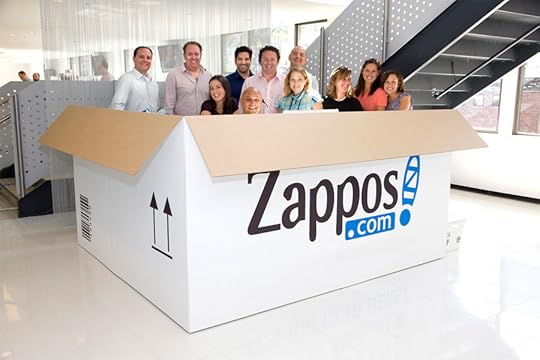 But for Zappos, things seem to have become a wee bit complicated in the full adoption of Holacracy. On the surface, it doesn’t look as though everyone is welcoming the new organizational operating model.
But for Zappos, things seem to have become a wee bit complicated in the full adoption of Holacracy. On the surface, it doesn’t look as though everyone is welcoming the new organizational operating model.
As the Holacracy pilot concluded at Zappos, the “new” organizational model was to be fully implemented to begin the 2015 year. Some three months into 2015, however, Tony issued a 4,552 word email to Zappos employees that contained three main messages:
We aren’t where we should be with the shift to Holacracy;
We aren’t giving up on Holacracy – in fact, we’re doubling-down on our efforts;
If you’re not on the Holacracy bus by April 30, get out.
What’s puzzling to me (irony point two) is that Tony had to issue the email at all.
Wasn’t this the culture of an organization that everyone wants to work at?
Wasn’t this the culture of an organization where customers consistently rave about their “wow” experiences?
Wasn’t this the culture of an organization that equally serves purpose with profit, relentlessly focusing on the customer experience?
Quite simply, wasn’t this the culture of an organization that had figured out the link between an engaged workforce and a “purpose with profit” bottom line?
By April 30 (deadline day for those to get on the Holacracy bus), 210 Zappos employees took up Tony’s new “offer” and accepted a severance package of at least three months in wages as well as benefits.
To put things into perspective, 14% of the Zappos workforce left on April 30, essentially matching their annual voluntary attrition rate in one day. I don’t know about you, but when 14% of my organization leaves in one day, there is something amiss if not awry. When I was on my tour at Zappos earlier in 2015, I brought up Holacracy on several occasions with various employees I came into contact with. “Change is good,” was often cited but you could smell the awkwardness that Holacracy was causing. (And my experience at Zappos was several weeks before Tony’s long email.)
The organization seems nonplussed about the number of exits. John Bunch, the Zappos employee who is leading the company’s transition to Holacracy said, “Whatever the number of people who took the offer was the right number as they made the decision that was right for them and right for Zappos.”
But shouldn’t the company be worried?
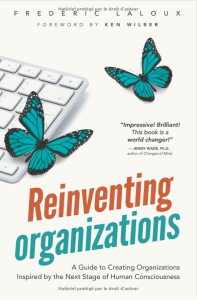 Embedded inside Tony’s late March email missive was a reference to a book by Belgian consultant Frederic Laloux, Reinventing Organizations: A Guide to Creating Organizations Inspired by the Next Stage of Human Consciousness. Coincidentally, I had begun reading the book in early March, so the timing of Tony’s email was impeccable.
Embedded inside Tony’s late March email missive was a reference to a book by Belgian consultant Frederic Laloux, Reinventing Organizations: A Guide to Creating Organizations Inspired by the Next Stage of Human Consciousness. Coincidentally, I had begun reading the book in early March, so the timing of Tony’s email was impeccable.
Through the use of several case studies, Laloux works his way through a series of organizational structures which, in his view, are representations of different and historical organizational designs. Each type has been branded as a colour.
For example, a “Red” organization (what he also coins “impulsive”) was formed some 10,000 years ago, one that is led by a “power chief” who is ruthless and uses fear as the motivating glue in all operations. Authority in this case is very commanding, citing historical examples like tribes and more recent examples like the Mafia and street gangs as “Red” organizations. He used the wolf pack as a guiding metaphor to depict these types of firms.
A “Green” organization (coined “pluralistic” by Laloux) focuses on empowerment and values-driven culture. The guiding metaphor for a green organization as described by Laloux is “family.” He even cites Zappos as a perfect example of a Green-pluralistic organization in the book (page 175).
But the crux of Laloux’s thesis is that organizations should reinvent themselves toward a “Teal” colour — the evolutionary model, as he describes. Evolutionary-Teal organizations reveal three breakthroughs:
Self-management: operate effectively with a system based on peer relationships, without the need for either hierarchy or consensus.
Wholeness: develop a consistent set of practices that invite us to reclaim our inner wholeness and bring all of who we are to work.
Evolutionary purpose: seen as having a life and sense of direction on their own — members are invited to listen in and understand what the organization wants to become, what purpose it wants to serve.
Personally, I found the book to be reverse engineered. Dave Snowden went further, and referred to it as, “the most trivial management book I had read in a long time.”
The case studies used did seem to define Laloux’s so-called “Evolutionary-Teal” organization rather well, but self-management, wholeness and evolutionary purpose as a basis for business reeks of cultist cuteness, not an organizational design model that delivers both profit and purpose. Any organization looking to shift to “Teal” might want to first start with their existing operating culture.
What types of attributes are embedded into existing leadership practices and models? Should they be redefined? How do teams operate with one another? How do leaders treat their employees? Their customers? What systems and processes are in place to expedite ideation? What frameworks and technologies are used for employees to collaborate with one another?
It’s no secret millions of employees remain disengaged, if not disenfranchised at their places of work. But for an organization to shift from “command and control” to “evolutionary-teal” misses the chance to create a more engaging, connected and collaborative organization with existing structures.
Moving from a very hierarchical and “command and control” environment to the Teal colour is not for the faint of heart. In terms of Laloux’s book, I found it very difficult to envision companies in today’s ultra-competitive and stock-market centered world to shift to such an operating model. Noble? Yes. Practical? Not at all.
This brings me back to Zappos.
Tony Hsieh mentioned in his long email to employees that he had discussed the book with the Reinventing Organizations author himself over a Skype call. He encapsulates his discussion with Laloux into two main points, as a basis for introducing Holacracy and self-based management. The first centers around pressure:
We need to figure out what the antibodies are for when a small number employee take advantage of the freedom gained from being in a no-manager organization, or else it will demoralize the other employees. He [Laloux] said that in general, research has shown that peer-pressure based systems work the best. For certain types of job functions where there are easy metrics to measure performance, a public leaderboard ranking will naturally create peer pressure by showing which teams are performing and which aren’t.
If I’m reading between the lines, in order to successfully implement Holacracy, the organization has to simultaneously introduce a public shaming system (akin to wearing a Scarlet Letter) so employees feel the pressure to perform.
That seems rather odd to me. I don’t see it in any way, shape or form as ‘culture building’. In fact, I think it’s the exact opposite.
The second point Tony addresses in his conversation with Laloux centers around conflict resolution:
Conflict resolution starts with the expectation that employees are responsible for taking the first step and having a 1:1 conversation with whomever they are having a conflict with (instead of going to their manager for example). He [Laloux] said the most important thing is the need to have a strong conflict resolution process clearly communicated and clearly understood by everyone so employees know what to do.
That seems sensible to me, but what happens when it involves some form of harassment? Or what if an employee isn’t pulling his weight in the call center (e.g. Jim never volunteers for the call-center shifts on Thanksgiving or Christmas Eve) and claims it’s his right to work whenever he feels like it?
But what I don’t fully understand revolves around the point of motive. What was the motive of Zappos (or Tony) to shift toward Holacracy and a completely self-managed operating structure in the first place? Were there operating processes that were inhibiting Zappos’ quest to “deliver wow”? Were there struggles in their distribution channels, marketing plans, Customer Loyalty Team efforts or elsewhere that aren’t documented?
Did the company feel as though the culture was suffering, and thus a reinvention was necessary?
Perhaps there is a clue in the closing words of Tony’s email:
Like all the bold steps we’ve done in the past, it feels a little scary, but it also feels like exactly the type of thing that only a company such as Zappos would dare to attempt at this scale.
If an organization decides to become self-organizing — where peer-to-peer coaching is the organizational model, meetings are ad hoc, voluntary task forces comprise the operating mechanism and decisions are fully decentralized — does it make sense to issue a 4,552 word edict, forcing those employees who have helped to build up the “deliver wow” culture over time to leave the very place they’ve called their professional home?
In essence, is it “change for the sake of change” or is there some underlying business reason for the shift?
In defense, Zappos did release a statement on April 8, 2015 indicating “Holacracy is one of the many tools we plan on using to reach our destination,” and “our true journey is to becoming a fully self-managing organization that culminates in making our work more productive, fulfilling and meaningful.”
There isn’t a single employee on the planet who doesn’t yearn for a more “productive, fulfilling and meaningful” place of work, but I wonder aloud whether the hierarchical decision to enforce Holacracy isn’t (irony point three) potentially ruining the great culture that was carefully constructed over its relatively short tenure.
Will the company continue to ‘wow’ us all?
I know I’m going to watch eagerly in anticipation that Tony Hsieh — winner of the ACM Programming Contest in 1993 — will prove us all wrong, once again.
I hope his “bet everything on Holacracy” decision works out for him, Zappos and the customers it serves.
Now that will be a “wow” moment, indeed.
Originally published to FORBES.
__________
Dan Pontefract is the author of FLAT ARMY: Creating a Connected and Engaged Organization and is Chief Envisioner at TELUS Transformation Office. His next book, DUAL PURPOSE: Redefining the Meaning of Work, will publish November 10, 2015.
Dan's Related Posts:Holacracy Is Not The Answer To Your Employee Disengagement IssuesWaxing Lyrical On Leadership, Engagement, Purpose & InnovationThere Is Nothing Wrong With The Term ‘Company Culture’In Answer To Your Questions About FLAT ARMYTry Implementing Flexible Work Options to Increase Employee Engagement



